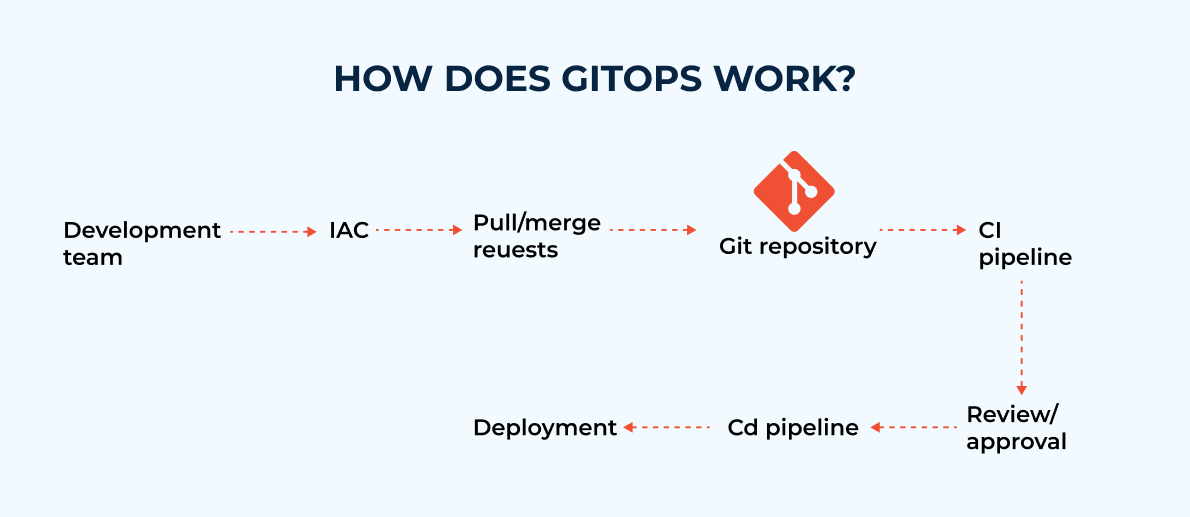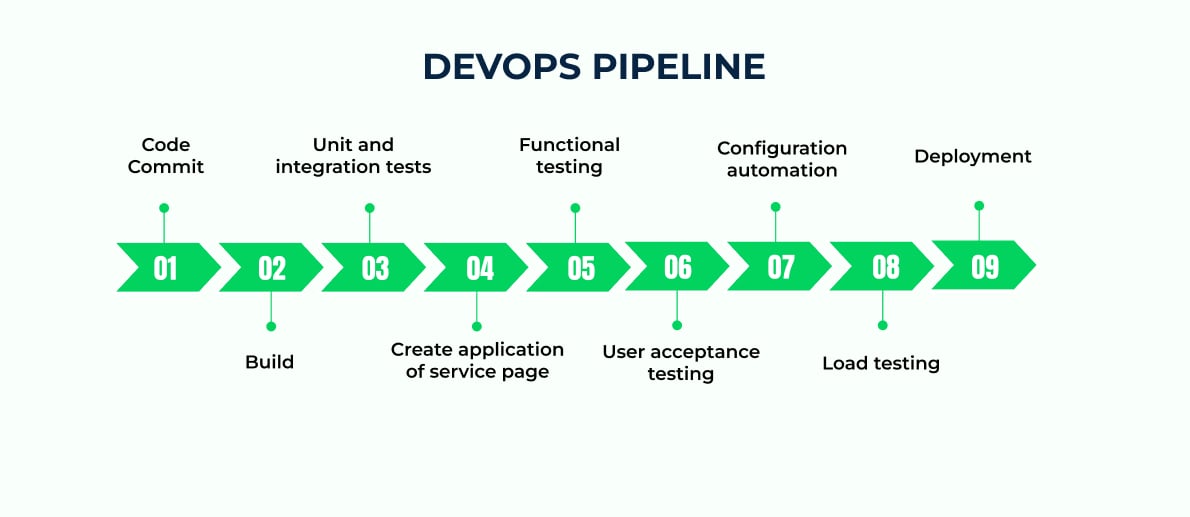-
GitOps vs. DevOps: An Overview
-
What is DevOps?
-
How does DevOps Work?
- DevOps Benefits and Challenges
-
What is GitOps?
-
How does GitOps work?
- GitOps Benefits and Challenges
-
DevOps vs GitOps: Differences
-
GitOps vs DevOps: An Interesting Comparison
-
GitOps vs DevOps: Which is Better?
-
GitOps vs. DevOps: Leveraging Complementary Strengths
-
DevOps vs GitOps: Final Words
GitOps vs. DevOps: An Overview
In the world of software development, the debate between GitOps vs DevOps continues to spark interest and discussions. DevOps is fundamentally a culture of continuous integration and deployment that aims to keep things running smoothly when it comes to cooperative coding. The GitOps practice builds on many of the same principles but with a specific focus on version tracking. Because both practices overlap greatly, it can be difficult to understand the differences. Here we’ll discuss GitOps vs DevOps and overlaps between the two.
What is DevOps?
A DevOps approach involves the collaboration of Development and IT Operations to process & deploy software in an automated & repeatable manner. It is a combination of the words ‘Development’ and ‘Operations.’ By using DevOps, organizations are able to deliver software applications and services more quickly. As a result, organizations can better serve their customers and compete more effectively. DevOps can be defined as the alignment of development and IT operations through improved communication and collaboration.
DevOps practices consist of automation, rapid software development, and automated infrastructure deployments.
How does DevOps Work?
DevOps combines the development, testing, and deployment stages of the software development life cycle into a streamlined, continuous process. In order to achieve this, you should automate as much of the process as possible by using tools such as version control systems, automated testing frameworks, and continuous integration/continuous deployment pipelines.

Following are the phases of the DevOps life cycle:
- Plan
This is the first stage of the DevOps practice. The development team makes a plan for executing the project after defining the project requirements and objectives. - Code
Using version control tools such as Git, Mercurial, and Subversion, the development team collaborates on the code. - Build
During the deployment process, the code is compiled and made executable. - Test
The code is tested automatically to check for bugs and errors and to ensure that it works as intended. - Deploy
Software features are released frequently into production using a CD pipeline. - Operate
As part of this phase, the operations team validates the software’s suitability for end users in a production environment. - Observe and monitor
Teams of developers and operations receive continuous monitoring and feedback, which allows them to identify and resolve issues as soon as possible.
DevOps Benefits and Challenges
Benefits of DevOps
- Release of products more quickly and a shorter time to market
- Increased productivity
- Efficiency in processes
- Production cycles are shorter
- A high-quality product
- A better operational support system
- Motivated and engaged employees
- An improved customer experience management system
- A clear product vision among team members
- A higher success rate for deployments
- A more efficient team
- Improved flexibility and support
- Reduced risk of product failure
- Self-improvement and cross-skilling
Challenges in DevOps
- Requires a positive mindset throughout the organization
- Reduced business security by outsourcing DevOps
- Legacy systems are challenging to deal with
- Security for CI/CD is a separate issue
- It is difficult to find the right pool of DevOps experts
- Challenges associated with the number of tools and switching between tools
- Transition challenges (organizational and technical)
What is GitOps?
Software developers and platform engineers use GitOps to store everything related to a project’s infrastructure in Git repositories, including code, configuration, and application files. Git triggers an update to cloud infrastructure or applications when they are pushed to source control. The single source of truth in GitOps is Git, which means only changes in Git can trigger builds and deployments of infrastructure and applications. GitOps is often used by organizations that use Kubernetes for container orchestration.
How does GitOps work?
In GitOps, IaC is treated in the same way as application code. In other words, infrastructure configurations are stored in Git repositories and are managed and versioned in the same way as application code. It ensures that changes made before deployment can be properly tested and reviewed.
A GitOps workflow involves a Git repository and a DevOps pipeline for the IaC project. The following is a simple GitOps workflow.

1. The IaC and application code should both be placed in a Git repository that serves as an SSOT.
2. Pull/merge requests should be created before pushing changes back to the main branch.
3. Implement a CI pipeline to automate tests, integrate changes, and verify configurations.
4. Make sure the changes are tested thoroughly before applying them to an environment by reviewing and approving them.
5. Continuously deploy the infrastructure using a CD pipeline.
GitOps Benefits and Challenges
GitOps Benefits
- Easy collaboration on infrastructure changes
- Better access control
- Faster time to market
- Mitigating risk
- Lower costs
- Fewer errors
- Transparency
- Easy rollbacks
- Faster environment duplication
- Excellent security
- Easy to audit
GitOps Challenges
- Doesn’t fix faulty practices
- A proliferation of repositories
- Git is not designed for programming updates
- Difficult to audit
- No help with secrets management
DevOps vs GitOps: Differences


There are some similarities between GitOps and DevOps. In DevOps, development teams and operations teams work together collaboratively to bring about cultural change.
With GitOps, you can leverage DevOps practices like collaboration, CI/CD, and version control to automate infrastructure and deploy applications. The developers can work with their familiar code repositories, while the operations department can put the other components in place.
Let’s have a closer look at DevOps vs GitOps in the table below.
GitOps vs DevOps: An Interesting Comparison
| GitOps | DevOps |
| A GitOps model is used to manage infrastructure provisioning and software deployment. | The focus of DevOps model is Continuous Integration and Continuous Deployment. |
| Git is the main tool used in GitOps tools. | CI/CD pipelines are the main tool used. |
| All GitOps are DevOps. | All DevOps are not GitOps. |
| This technique can be used with IaC, Kubernetes, and CI/CD pipelines. | Multiple tools can be used with this approach, including supply chain management and cloud configuration as code. |
| This aims for rapid development and minimizes the need for complex scripts. | Automating and deploying in a timely manner are key objectives. |
| Operational and development sequences become more fluid. | Different steps are maintained for development and operations. |
| As GitOps relies on a single VCS tool – Git – it is less flexible. | A DevOps approach is more flexible than a GitOps approach. |
| It provides speed, accuracy, and improved productivity. | By eliminating silos in a team and reducing effort, it reduces issue rates. |
| Focused on clean code and accuracy. | Code accuracy is less important. |
| Less open and strict | Open and less rigid |
GitOps vs DevOps: Which is Better?
DevOps and GitOps are emerging as popular approaches for improving software development processes and making deployments more efficient and quicker. The main difference between the two models is in the tools that are used, but the overall benefits are similar. A company’s needs and requirements determine which approach is right for them and which is “better”. A more ideal scenario would be to integrate GitOps with your DevOps process.
The CI process still relies on DevOps tools, so GitOps is not a replacement for DevOps. DevOps can be made more effective through continuous delivery processes with GitOps. Since GitOps is based on Kubernetes-native mechanisms and commands, developers need not adapt their workflows to work seamlessly with it. To integrate GitOps with DevOps processes, you can reach out to a DevOps services company.
GitOps vs. DevOps: Leveraging Complementary Strengths
Throughout this debate, it is evident that GitOps is not a replacement for DevOps. Traditional DevOps tools need to perform a full CI process. A Kubernetes cluster is deployed with GitOps for continuous delivery and deployment of software artifacts.
GitOps is based on source code principles that are familiar to all developers and uses Kubernetes-native mechanisms and commands. As a result, GitOps can boost DevOps practices in modern Kubernetes environments.
DevOps vs GitOps: Final Words
In the discussion of GitOps vs DevOps, GitOps has offered real value to many organizations by being a powerful tool that helps in managing systems’ cloud infrastructure. This offers many benefits to software service provider companies, as well as to DevOps teams by increasing productivity without blocking developers out with too many tools. DevOps brings a cultural change in how companies’ operational and development teams work together in a more collaborative way.
Both of these technologies also offer benefits, such as communication, stability, and visibility. Each approach can be beneficial, but which approach should be adopted depends on the type of business the company operates. Our DevOps experts can assist you if you are still unsure about which approach to use. Dedicated teams from OpenXcell deliver DevOps Consulting Services to help you accelerate projects and adopt DevOps best practices.








